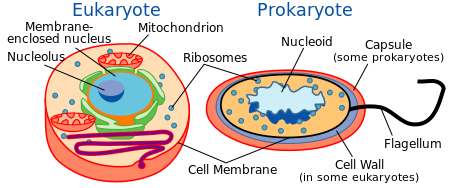
Back Sel Afrikaans Zelle (Biologie) ALS ህዋስ Amharic Celula AN Līfclēofa ANG कोशिका ANP خلية Arabic بنيقة ARY خليه ARZ কোষ (জীৱবিজ্ঞান) Assamese

In biology, the cell is the basic structure of organisms. All cells are made by the division of other cells.
The environment outside the cell is separated from the cytoplasm inside the cell by the cell membrane. Inside some cells, parts of the cell stay separate from other parts. These separate parts are called organelles (like small organs). They each do different things in the cell. Examples are the nucleus (where DNA is), and mitochondria (where chemical energy is converted).[1][2]
